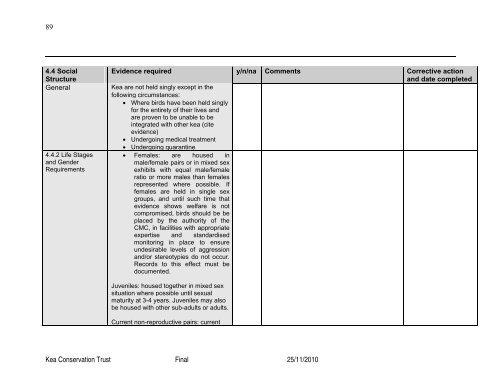(Nestor notabilis) Husbandry Manual - Kea Conservation Trust
(Nestor notabilis) Husbandry Manual - Kea Conservation Trust
(Nestor notabilis) Husbandry Manual - Kea Conservation Trust
You also want an ePaper? Increase the reach of your titles
YUMPU automatically turns print PDFs into web optimized ePapers that Google loves.
89<br />
4.4 Social<br />
Structure<br />
General<br />
4.4.2 Life Stages<br />
and Gender<br />
Requirements<br />
Evidence required<br />
<strong>Kea</strong> are not held singly except in the<br />
following circumstances:<br />
• Where birds have been held singly<br />
for the entirety of their lives and<br />
are proven to be unable to be<br />
integrated with other kea (cite<br />
evidence)<br />
• Undergoing medical treatment<br />
• Undergoing quarantine<br />
y/n/na Comments Corrective action<br />
and date completed<br />
• Females: are housed in<br />
male/female pairs or in mixed sex<br />
exhibits with equal male/female<br />
ratio or more males than females<br />
represented where possible. If<br />
females are held in single sex<br />
groups, and until such time that<br />
evidence shows welfare is not<br />
compromised, birds should be be<br />
placed by the authority of the<br />
CMC, in facilities with appropriate<br />
expertise and standardised<br />
monitoring in place to ensure<br />
undesirable levels of aggression<br />
and/or stereotypies do not occur.<br />
Records to this effect must be<br />
documented.<br />
Juveniles: housed together in mixed sex<br />
situation where possible until sexual<br />
maturity at 3-4 years. Juveniles may also<br />
be housed with other sub-adults or adults.<br />
Current non-reproductive pairs: current<br />
<strong>Kea</strong> <strong>Conservation</strong> <strong>Trust</strong> Final 25/11/2010












